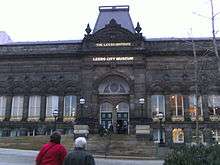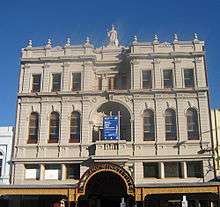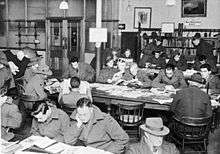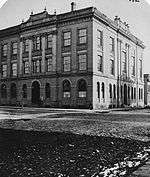Mechanics' Institutes

Mechanics' Institutes are educational establishments, originally formed to provide adult education, particularly in technical subjects, to working men. As such, they were often funded by local industrialists on the grounds that they would ultimately benefit from having more knowledgeable and skilled employees (such philanthropy was shown by, among others, Robert Stephenson, James Nasmyth, John Davis Barnett and Joseph Whitworth). The Mechanics' Institutes were used as 'libraries' for the adult working class, and provided them with an alternative pastime to gambling and drinking in pubs.
Origins
The world's first Mechanics' Institute was established in Edinburgh, Scotland in October 1821 as the School of Arts of Edinburgh (later Heriot-Watt University), with the provision of technical education for working people and professionals. Its purpose was to "address societal needs by incorporating fundamental scientific thinking and research into engineering solutions". The school revolutionised access to education in science and technology for ordinary people.
The second Institute in Scotland was incorporated in Glasgow in November 1823, built on the foundations of a group started at the turn of the previous century by George Birkbeck. Under the auspices of the Andersonian University (est. 1796), Birkbeck had first instituted free lectures on arts, science and technical subjects in 1800. This mechanics' class continued to meet after he moved to London in 1804, and in 1823 they decided to formalise their organisation by incorporating themselves as the Mechanics' Institute.
The first Mechanics' Institute in England was opened at Liverpool in July 1823.[1] The London Mechanics' Institute (later Birkbeck College) followed in December 1823, and the Mechanics' Institutes in Ipswich and Manchester (later to become UMIST) in 1824.[2] By the mid-19th century, there were over 700 institutes in towns and cities across the UK and overseas, some of which became the early roots of other colleges and universities. See for example the University of Gloucestershire, which has the Cheltenham Mechanics' Institute (1834) and Gloucester Mechanics' Institute (1840) within its history timeline. It was as a result of delivering a lecture series at the Cheltenham Mechanics' Institute that the famous radical George Holyoake was arrested and then convicted on a charge of blasphemy.[3]
In Australia, the first Mechanics' Institute was established in Hobart in 1827, followed by the Sydney Mechanics' School of Arts[4] in 1833, Newcastle School of Arts in 1835, then the Melbourne Mechanics' Institute established in 1839 (renamed The Melbourne Athenaeum in 1873). From the 1850s, Mechanics' Institutes quickly spread throughout Victoria wherever a hall, library or school was needed. Over 1200 Mechanics' Institutes were built in Victoria but just over 500 remain today, and only six still operate their lending library services.[5]
.jpg)
The Industrial Revolution created a new class of reader in Britain by the end of the 18th century, 'mechanics,' who were civil and mechanical engineers in reality. The Birmingham Brotherly Society was founded in 1796 by local mechanics to fill this need, and was the forerunner of Mechanics' Institutes, which grew in England to over seven hundred in number by 1850.[6]
G. Jefferson explains that:
The first phase, the Mechanics Institute movement, grew in an atmosphere of interest by a greater proportion of the population in scientific matters revealed in the public lectures of famous scientists such as Faraday. More precisely, as a consequence of the introduction of machinery a class workmen emerged to build, maintain and repair, the machines on which the blessing of progress depended, at a time when population shifts and the dissolving influences of industrialization in the new urban areas, where these were concentrated, destroyed the inadequate old apprentice system and threw into relief the connection between material advancement and the necessity of education to take part in its advantages.[7]
Small tradesmen and workers could not afford subscription libraries, so for their benefit, benevolent groups and individuals created "Mechanics' Institutes" that contained inspirational and vocational reading matter, for a small rental fee. Later popular non-fiction and fiction books were added to these collections. The first known library of this type was the Birmingham Artisans' Library, formed in 1823.

Some mechanics' libraries only lasted a decade or two, many eventually became public libraries or were given to local public libraries after the Public Libraries Act 1850 passed. Though use of the mechanics' library was limited, the majority of the users were favourable towards the idea of free library use and service, and were a ready to read public when the establishment of free libraries occurred.[8]
Beyond a lending library, Mechanics' Institutes also provided lecture courses, laboratories, and in some cases contained a museum for the member's entertainment and education. The Glasgow Institute, founded in 1823, not only had all three, it was also provided free light on two evenings a week from the local Gas Light Company. The London Mechanics' Institute installed gas illumination by 1825, revealing the demand and need for members to use the books,[6] (founded at the same time as Glasgow's).
Existing Mechanics' Institutes


Thousands of Mechanics' Institutes still operate throughout the world—some as libraries, parts of universities, adult education facilities, theatres, cinemas, museums, recreational facilities, or community halls.
Australia
- Ballarat Mechanics' Institute, Ballarat
- Berwick Mechanics' Institute, Berwick
- Briagolong Mechanics' Institute, Briagolong
- Footscray Mechanics' Institute Inc. Library[9]
- Kilmore Mechanics' Institute & Free Library
- Kyneton Mechanics' Institute[10]
- Little River Mechanics' Institute, Little River
- Maldon Athenaeum, Maldon
- Melbourne Athenaeum
- Narre Warren Mechanics Institute (1891)
- Prahran Mechanics' Institute
- Purlewaugh Mechanics' Institute
- Purnim Mechanics' Institute, Purnim
- Mechanics' Institute, Sorrento
- Sydney Mechanics' School of Arts
- Romsey Mechanics Institute
- Richmond School of Arts[11]
- Guildford Soldiers Memorial School of Arts[12]
- Cronulla School of Arts
- Carlton School of Arts hall[13]
- Sunny Corner School of Arts.[14]
- Cookamidgera Mechanics Institute.
- Warrandyte Mechnanics' Institute, Warrandyte[15]
Canada
- Atwater Library of the Mechanics' Institute, Montreal, Quebec
- UK
- Bradford Mechanics' Institute Library 76 Kirkgate, BD1 1SZ
- Burnley Mechanics, Burnley, Lancashire
- Brechin Mechanics Institute, Angus
- Epworth Mechanics Institute, North Lincs, UK,[16]
- Marsden, West Yorkshire, HD7 6BW
USA
- General Society of Mechanics and Tradesmen of the City of New York
- Mechanics' Institute, San Francisco, California
- Mechanics Hall, Worcester
- Maine Charitable Mechanics Foundation
Historical Mechanics' Institutes
Australia
- New South Wales
- Lawson Mechanics' Institute
- Carlingford Mechanics' Institute[17]
- Penrith Mechanics' Institute
- Kogarah School of Arts (1886),[18]
- The Blacktown Mutual Improvement Association, (1905),[19]
- Oatley School of Arts (1905)
- Victoria
- Prahran Mechanics' Institute
- Melbourne Athenaeum
- Ballarat Mechanics' Institute
- Berwick Mechanics' Institute
- Footscray Mechanics' Institute Inc. Library
- Maldon Athenaeum
- Western Australia
Canada


Atlantic Provinces
Ontario
- Barrie Mechanics' Institute
- Brockville Mechanics' Institute now Brockville Public Library[20]
- Bytown Mechanics' Institute later Mechanics' Institute and Athenaeum of Ottawa now Ottawa Public Library
- Elmsley Library Association and Mechanics' Institute
- Elora Mechanics' Institute
- Farmers' Mechanics' Institute of Streetsville
- Grand Trunk Railway Mechanics' Institute
- Guelph Farmers' and Mechanics' Institute, now Guelph Public Library[21]
- Hamilton and Gore Mechanics' Institute
- Kingston Mechanics' Institute
- London Mechanics' Institute
- Mechanics' Institute, Coldstream
- Mechanics' Institute (Orillia)
- Mechanics' Institute of Goderich
- Mechanics' Institute of Point Edward
- Midland Railroad Mechanics' Institute
- Napanee Mechanics' Institute
- Newmarket Farmers' Mechanics' Institute
- Owen Sound Mechanics Institute
- Peterborough Mechanics' Institute
- St. Catharines Mechanics' Institute Library
- Toronto Mechanics' Institute
- Woodstock Mechanics' Institute
Quebec

- Montreal Mechanics Institute
- Quebec Mechanics' Institute
Hong Kong
United Kingdom
- University of South Wales, Newport – The old mechanics institute building was sold off and has been converted to private apartments.
- Bradford Mechanics' Institute Library
- School of Arts of Edinburgh, renamed to Heriot-Watt University in 1966
- Swindon Mechanics' Institute, UK
- Lutterworth, UK
- Darlington Mechanics Institute, built in 1854, as of 2014 a nightclub and bar.[22]
- Eyam, UK
- Essex, UK
- Royston, Hertfordshire, built 1855, later became the Town Hall
- Leeds Mechanics' Institute (West Yorkshire) designed by Cuthbert Brodrick, now Leeds City Museum
- Manchester, forerunner of University of Manchester Institute of Science and Technology, which merged with Victoria University of Manchester to form the University of Manchester
- Birkbeck, University of London
- Ipswich Institute, Suffolk, UK – Ipswich Institute Website
- Otley, Yorkshire, UK
- Wolverhampton (Queen Street, c1835)[23]
- Lurgan, County Armagh. 69 Market Street.
- Liverpool Mechanics School of Arts, founded 1825, renamed Liverpool Mechanics Institution in 1832, which later became the Liverpool Institute High School for Boys and from 1996 the Liverpool Institute for Performing Arts.
United States of America
- 1792 The Mechanic Library Society of New Haven, Connecticut is founded. It is chartered the following year and is eventually superseded in New Haven by The Young Men's Institute Library.
- 1795 The Massachusetts Charitable Mechanic Association of Boston, Massachusetts, was "formed for the sole purposes of promoting the mechanic arts and extending the practice of benevolence."
- 1820 General Society of Mechanics and Tradesmen of the City of New York established. Renamed and became the Mechanics Institute in 1858.
- 1821 The English High School is established in Boston, MA, as the first public high school, with leadership from the Massachusetts Charitable Mechanic Association.
- 1824 "The Franklin Institute of the State of Pennsylvania for the Promotion of the Mechanic Arts" opens in Philadelphia.
- 1826 The Maryland Institute for the Promotion of the Mechanic Arts opens in Baltimore.
- 1827 Boston establishes a Mechanics' Institute.
- 1828 In Cincinnati, the Ohio Mechanics Institute (OMI) is founded on 20 November to "facilitate the diffusion of useful knowledge" to "ingenious artisans and mechanics."
- Richmond, Virginia – Mechanics' Institute was located at 9th and Bank Streets[24] Marshall Street properties are now part of Virginia Commonwealth University[25] and Richmond Public Schools[26]
- Rochester, New York – 1885 Mechanics Institute merged with the Rochester Athenium in 1891 to become the Rochester Athenaeum and Mechanics Institute. Renamed to Rochester Institute of Technology (RIT) in 1944.[27]
- An "Agricultural and Mechanical" university – one that includes a college of agriculture and a college of engineering, provided for by the Morrill Land-Grant Colleges Act
Land-grant universities
- Alabama Agricultural and Mechanical University
- Florida A&M University
- Louisiana State University and A&M College, commonly referred to as just "Louisiana State University"
- Southern University and A&M College
- Texas A&M University, the flagship institution of the Texas A&M University System
Community colleges
- Northeastern Oklahoma A&M College, a community college
Mechanics' Worldwide Conferences
Three conferences have been held on Mechanics' Institutes:
- Buildings, Books and Beyond: Mechanics' Worldwide (2004) by the Prahran Mechanics' Institute at Prahran, Victoria, Australia.[28]
- Self Help: Mechanics' Worldwide (2009) by the Bath Royal Literary and Scientific Institution at Bath, Somerset, England.[29]
- Buildings, Books and Blackboards:Intersecting Narratives (2012) A combined conference of the Australian and New Zealand History of Education Society (ANZHES), Mechanics' Institutes Worldwide (under the auspices of MIV) and incorporating the 10th Library history forum.
The fourth conference is planned for November 2016:
- Reinvention: Thriving in the 21st Century – International Conference of Independent Libraries and Mechanics’ Institutes[30]
See also
References
- ↑ Speeches of Henry, Lord Brougham Vol. II, 1841, Lea and Blanchard, Philadelphia
- ↑ Kidd, Alan J. (1993). Manchester (Town and city histories). Manchester: Ryburn. pp. 57–8. ISBN 1-85331-016-6.
- ↑ Turner, C M, Thesis (PhD), 'Politics in Mechanics' Institutes 1820–1850', University of Leicester, 1980, and references therein
- ↑ "SMSA (Sydney Mechanics' School of Arts)". SMSA.
- ↑ Lowden, Bronwyn (2010). Mechanics' Institutes, Schools of Arts, Athenaeums, etc.: An Australian Checklist – 3rd Edition. Donvale, Australia: Lowden Publishing Co. pp. 64–111. ISBN 978-1-920753-16-0.
- 1 2 Kilgour, Frederick, The Evolution of the Book. New York, Oxford: Oxford University Press, 1998, p. 99.
- ↑ Jefferson, G.. Libraries and Society. Cambridge & London, Great Britain: James Clark & CO. LTD., 1969, p. 21.
- ↑ Harris, Michael. History of Libraries in the Western World. 4th ed. Metuchen, N.J.: Scarecrow Press, 1995, p. 153.
- ↑ "FMI Library". fmilibrary.org.
- ↑ "Kyneton Mechanics Institute". mrsc.vic.gov.au.
- ↑ Trove.
- ↑ Sydney Morning Herald 9 October 1933 page 6.
- ↑ Catherine Freyne, 2010 The School of Arts movement.
- ↑ Sunny Corner School of Arts Trust.
- ↑ "The Warrandyte Mechanics Institute Hall". WMIAA. WMIAA. Retrieved 8 October 2015.
- ↑ Epworth Mechanics Institute
- ↑ Cumberland Argus and Fruitgrowers Advocate, 3 June 1922 p 8.
- ↑ Roger Morris, 'Sydney suburban Schools of Arts: From and for the community' in Schools of Arts and Mechanics' Institutes: From and for the community – Proceedings of a National Conference, University of Technology, Sydney, 2002, p 79
- ↑ Catherine Freyne, The School of Arts movement (Sydney Mechanics' School of Arts, 2010).
- ↑ "Brockville Public Library". ancestry.com.
- ↑ "Our History". Guelph Public Library. Retrieved 15 October 2012.
- ↑ Lloyd, Chris (10 March 2014). "HISTORY: School for rude mechanicals". The Northern Echo. Retrieved 11 May 2014.
- ↑ "Victorian Wolverhampton, a town though its buildings". Wolverhampton History & Heritage Website. Retrieved 15 October 2012.
- ↑ "Mechanics' Institute". mdgorman.com.
- ↑ "Virginia Mechanics Institute Building – VCU Maps". vcu.edu.
- ↑ "Richmond Technical Center". richmond.k12.va.us.
- ↑ "A01.0 History, Accreditation and Legacy – University Policies – RIT". rit.edu.
- ↑ Mechanics' Worldwide (2004) Buildings, Books and Beyond: Mechanics' Worldwide Conference 2009 – Proceedings of the first International Conference convened by the Prahran Mechanics' Institute. Prahran, Victoria, Australia: Prahran Mechanics' Institute. ISBN 0-9756000-1-X
- ↑ Mechanics' Worldwide 2009. (2009) Self Help: Mechanics' Worldwide Conference 2009 – Proceedings of the second International Conference convened by the Bath Royal Literary and Scientific Institution. Donvale, Victoria, Australia: Lowden Publishing Co. ISBN 978-1-920753-18-4
- ↑ http://www.milibrary.org/reinvention
